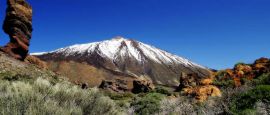Getting around Tenerife
All seven Canary Islands have their own airports. Tenerife has two; Reina Sofia in the south and Los Rodeos in the north. Most European flights land at Tenerife South airport while Tenerife North is better served by flights from mainland Spain and elsewhere in the Canaries.
Inter-island connections are served by BinterCanarias (www.bintercanarias.com) and CanaryFly (www.canaryfly.es). Although routes run between Tenerife South Airport and airports on the other islands, they are infrequent compared to the multiple daily services that depart from Tenerife North Airport.
Tenerife’s established road infrastructure and clear signposting makes it an easy island to drive around. It helps to beware that local drivers use their indicators instead of hazard warning lights to warn of dangers or even to warn they will be stopping at a pedestrian crossing. Roundabouts appear to be a mystery to local drivers with most using the outside lane only.
Motorways and major roads are of a high standard with smooth surfaces and clear markings. Mountain roads can be narrow and winding and some surfaces can be rough, especially in more rural locations.
Tenerife has a toll-free motorway network which connects the capital city and airports with most major resorts on the island and there are plans to extend it to completely circumnavigate the island.
There are more than 100 car hire companies on Tenerife including most of the major car hire companies who have offices at the two airports and in the main urban centres. Car hire is good value for money on the island and most cars are less than two years old. Drivers must be over 21 to hire a car.
Taxis (tel +34 922 397 074; www.officialtaxitenerife.com) are metred and regulated. They can be found in all resorts, cities, towns and even most villages across Tenerife. You can flag down taxis in the street.
Road and mountain bikes can be hired from resorts and towns across the island, but be warned; there are some very steep hills in Tenerife. Not that that bothers Britain's Olympic cycling team or Bradley Wiggins, who use the island as a training ground.
For something more powerful, motorcycles and mopeds are available for hire in most major towns and resorts. Riders of motorcycles over 75cc must be at least 18. Crash helmets are compulsory.
Two red hazard triangles and a reflective vest or jacket must be kept in all vehicles – the latter in the car, not in the boot. Hire cars are equipped with all necessary legal requirements. Parking laws are rigorously enforced and illegally parked cars are often towed away.
The speed limit for motorways is 120kph (80mph). In built-up areas it's 50kph (30mph) and on other roads it's 90kph (56mph). Speed cameras are in operation on motorways and major roads. Safety belts are compulsory front and rear. Drink driving is a serious offence in Tenerife. The legal limit is just 0.25%, equivalent to less than one pint of beer or two glasses of wine.
Emergency breakdown service: Real Automóvil Club de España (RACE) (tel: 902 404 545; www.race.es).
Most foreign licences including Canadian, EU and US are accepted. Minimum third party insurance is compulsory. An original driving licence and proof of identity must be carried in the car at all times.
Most coastal resorts have central pedestrianised areas. Metered taxis are readily available and taxi ranks abound. The public bus service, TITSA (www.titsa.com), is a cheap and reliable way of getting around, and so is the tram that runs between Santa Cruz and La Laguna.
Bono prepaid cards offer a 50% discount on bus and tram journeys. They can be bought at any bus station or in kiosks displaying the green Bono circle.
There is no rail network in Tenerife, although a tram service operates between the northern cities of Santa Cruz and La Laguna (www.tranviatenerife.com).
An alternative means of travelling from island to island is by ferry. Two companies operate the various routes: Lineas Fred Olsen (www.fredolsen.es) and Naviera Armas (www.naviera-armas.com).
In Tenerife the ferry terminals are in Santa Cruz and Los Cristianos. Ferries to the western Canary Islands of La Gomera, El Hierro and La Palma operate from Los Cristianos and ferries to the eastern islands of Lanzarote, Gran Canaria and Fuerteventura depart from Santa Cruz.
Do you have any Feedback about this page?
© 2025 Columbus Travel Media Ltd. All rights reserved. No part of this site may be reproduced without our written permission, click here for information on Columbus Content Solutions.




 You know where
You know where